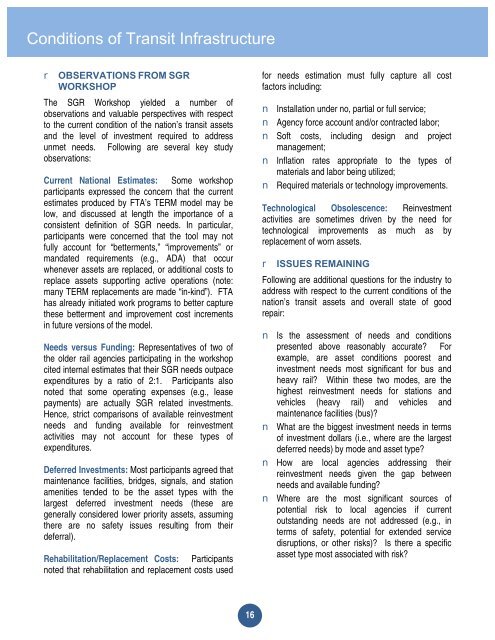Beginning the Dialogue - Report on SGR - Federal Transit ...
Beginning the Dialogue - Report on SGR - Federal Transit ...
Beginning the Dialogue - Report on SGR - Federal Transit ...
Create successful ePaper yourself
Turn your PDF publications into a flip-book with our unique Google optimized e-Paper software.
C<strong>on</strong>diti<strong>on</strong>s of <strong>Transit</strong> Infrastructure<br />
r OBSERVATIONS FROM <strong>SGR</strong><br />
WORKSHOP<br />
The <strong>SGR</strong> Workshop yielded a number of<br />
observati<strong>on</strong>s and valuable perspectives with respect<br />
to <str<strong>on</strong>g>the</str<strong>on</strong>g> current c<strong>on</strong>diti<strong>on</strong> of <str<strong>on</strong>g>the</str<strong>on</strong>g> nati<strong>on</strong>’s transit assets<br />
and <str<strong>on</strong>g>the</str<strong>on</strong>g> level of investment required to address<br />
unmet needs. Following are several key study<br />
observati<strong>on</strong>s:<br />
Current Nati<strong>on</strong>al Estimates: Some workshop<br />
participants expressed <str<strong>on</strong>g>the</str<strong>on</strong>g> c<strong>on</strong>cern that <str<strong>on</strong>g>the</str<strong>on</strong>g> current<br />
estimates produced by FTA’s TERM model may be<br />
low, and discussed at length <str<strong>on</strong>g>the</str<strong>on</strong>g> importance of a<br />
c<strong>on</strong>sistent definiti<strong>on</strong> of <strong>SGR</strong> needs. In particular,<br />
participants were c<strong>on</strong>cerned that <str<strong>on</strong>g>the</str<strong>on</strong>g> tool may not<br />
fully account for “betterments,” “improvements” or<br />
mandated requirements (e.g., ADA) that occur<br />
whenever assets are replaced, or additi<strong>on</strong>al costs to<br />
replace assets supporting active operati<strong>on</strong>s (note:<br />
many TERM replacements are made “in-kind”). FTA<br />
has already initiated work programs to better capture<br />
<str<strong>on</strong>g>the</str<strong>on</strong>g>se betterment and improvement cost increments<br />
in future versi<strong>on</strong>s of <str<strong>on</strong>g>the</str<strong>on</strong>g> model.<br />
Needs versus Funding: Representatives of two of<br />
<str<strong>on</strong>g>the</str<strong>on</strong>g> older rail agencies participating in <str<strong>on</strong>g>the</str<strong>on</strong>g> workshop<br />
cited internal estimates that <str<strong>on</strong>g>the</str<strong>on</strong>g>ir <strong>SGR</strong> needs outpace<br />
expenditures by a ratio of 2:1. Participants also<br />
noted that some operating expenses (e.g., lease<br />
payments) are actually <strong>SGR</strong> related investments.<br />
Hence, strict comparis<strong>on</strong>s of available reinvestment<br />
needs and funding available for reinvestment<br />
activities may not account for <str<strong>on</strong>g>the</str<strong>on</strong>g>se types of<br />
expenditures.<br />
Deferred Investments: Most participants agreed that<br />
maintenance facilities, bridges, signals, and stati<strong>on</strong><br />
amenities tended to be <str<strong>on</strong>g>the</str<strong>on</strong>g> asset types with <str<strong>on</strong>g>the</str<strong>on</strong>g><br />
largest deferred investment needs (<str<strong>on</strong>g>the</str<strong>on</strong>g>se are<br />
generally c<strong>on</strong>sidered lower priority assets, assuming<br />
<str<strong>on</strong>g>the</str<strong>on</strong>g>re are no safety issues resulting from <str<strong>on</strong>g>the</str<strong>on</strong>g>ir<br />
deferral).<br />
Rehabilitati<strong>on</strong>/Replacement Costs: Participants<br />
noted that rehabilitati<strong>on</strong> and replacement costs used<br />
16<br />
for needs estimati<strong>on</strong> must fully capture all cost<br />
factors including:<br />
n Installati<strong>on</strong> under no, partial or full service;<br />
n Agency force account and/or c<strong>on</strong>tracted labor;<br />
n Soft costs, including design and project<br />
management;<br />
n Inflati<strong>on</strong> rates appropriate to <str<strong>on</strong>g>the</str<strong>on</strong>g> types of<br />
materials and labor being utilized;<br />
n Required materials or technology improvements.<br />
Technological Obsolescence: Reinvestment<br />
activities are sometimes driven by <str<strong>on</strong>g>the</str<strong>on</strong>g> need for<br />
technological improvements as much as by<br />
replacement of worn assets.<br />
r ISSUES REMAINING<br />
Following are additi<strong>on</strong>al questi<strong>on</strong>s for <str<strong>on</strong>g>the</str<strong>on</strong>g> industry to<br />
address with respect to <str<strong>on</strong>g>the</str<strong>on</strong>g> current c<strong>on</strong>diti<strong>on</strong>s of <str<strong>on</strong>g>the</str<strong>on</strong>g><br />
nati<strong>on</strong>’s transit assets and overall state of good<br />
repair:<br />
n Is <str<strong>on</strong>g>the</str<strong>on</strong>g> assessment of needs and c<strong>on</strong>diti<strong>on</strong>s<br />
presented above reas<strong>on</strong>ably accurate? For<br />
example, are asset c<strong>on</strong>diti<strong>on</strong>s poorest and<br />
investment needs most significant for bus and<br />
heavy rail? Within <str<strong>on</strong>g>the</str<strong>on</strong>g>se two modes, are <str<strong>on</strong>g>the</str<strong>on</strong>g><br />
highest reinvestment needs for stati<strong>on</strong>s and<br />
vehicles (heavy rail) and vehicles and<br />
maintenance facilities (bus)?<br />
n What are <str<strong>on</strong>g>the</str<strong>on</strong>g> biggest investment needs in terms<br />
of investment dollars (i.e., where are <str<strong>on</strong>g>the</str<strong>on</strong>g> largest<br />
deferred needs) by mode and asset type?<br />
n How are local agencies addressing <str<strong>on</strong>g>the</str<strong>on</strong>g>ir<br />
reinvestment needs given <str<strong>on</strong>g>the</str<strong>on</strong>g> gap between<br />
needs and available funding?<br />
n Where are <str<strong>on</strong>g>the</str<strong>on</strong>g> most significant sources of<br />
potential risk to local agencies if current<br />
outstanding needs are not addressed (e.g., in<br />
terms of safety, potential for extended service<br />
disrupti<strong>on</strong>s, or o<str<strong>on</strong>g>the</str<strong>on</strong>g>r risks)? Is <str<strong>on</strong>g>the</str<strong>on</strong>g>re a specific<br />
asset type most associated with risk?

















